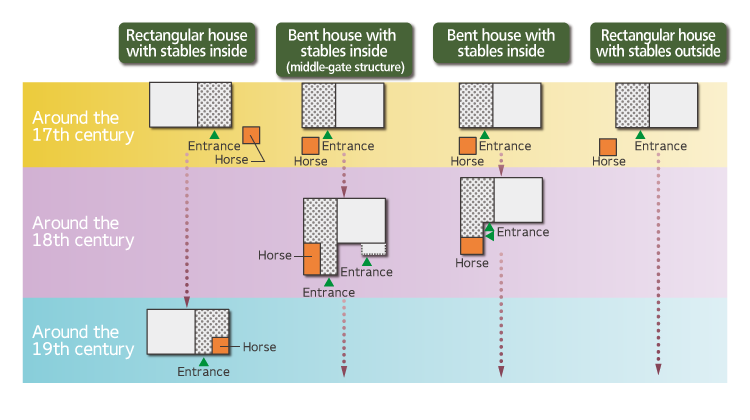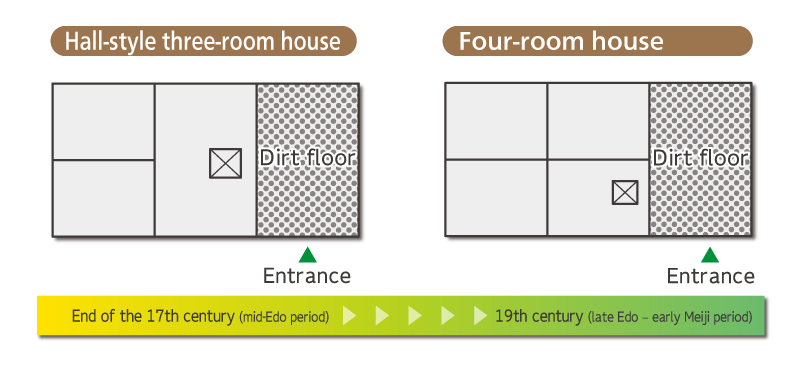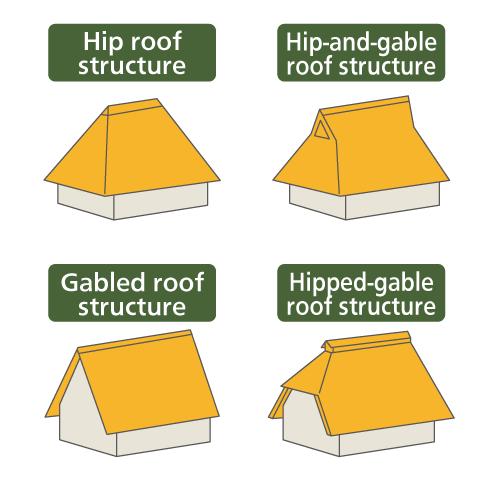Styles of Kominka (traditional houses) in the Tohoku region
This is English site
Basic floor plan
At the beginning of the 17th century (early Edo period), farmers in the Tohoku region lived in rectangular houses (called sugoya). Later, due to efforts to facilitate horse breeding, measures against snowfall during the winter and the technical improvement of sericulture, the floor plan gradually changed.
From the beginning of the 18th century (mid-Edo period), in cold areas with heavy snowfall, people began to keep horses for agricultural use in a corner of the dirt floor of the main house. Later, stables were built inside the dirt-floored indoor space. In Akita Prefecture and the Aizu area of Fukushima Prefecture, the middle-gate structure, marked with a dirt floor that linked the public road to the indoor space, was adopted. In some parts of Iwate Prefecture, bent houses with large stables became popular to breed horses for sale.
Basic floor plan of traditional houses and the position of stables

Appearance
From the 17th century (early Edo period), the height of houses’ eaves increased with each new build in every area.
From the 19th century (late Edo period), especially in areas where sericulture was popular, including Fukushima, Miyagi and Yamagata Prefectures, builders began to construct houses with very high eaves and a mezzanine.
Thanks to the increased height of the eaves, it was possible to enlarge the width of the extended roof surrounding the main house or install a mezzanine, which embellished the appearance of the house.
Layout
At the beginning of the 17th century (early Edo period), farmers and their family members typically lived in a one-story house with a dirt-floored space. It is likely that there was no partition inside, and the house was divided into sections with either a dirt floor or a dirt floor covered with straw and mats. From the end of the 17th century (mid-Edo period), there were many hall-style three-room houses in which the dirt floor covered with straw and mats was one step higher and covered with boards.
From the late 18th century to the 19th century (late Edo – early Meiji period), the four-room houses that developed from the previous style, or similar but slightly more complex forms, were widely adopted.

Roof types
Around the 17th century (early Edo period), most farmers’ houses in the Tohoku region adopted hip roofs.
Between the late 18th century and early 19th century (late Edo period), in areas where sericulture was popular, houses began to be equipped with a mezzanine and a loft, which largely modified the roof forms.
The hipped-gable roof was installed by putting windows in the roof and omitting the eaves on the gable side in order to let light into the mezzanine and the loft.
Four roof types

Supervisor: Dr. Kazuo Kusano, Professor Emeritus at Tohoku Institute of Technology
